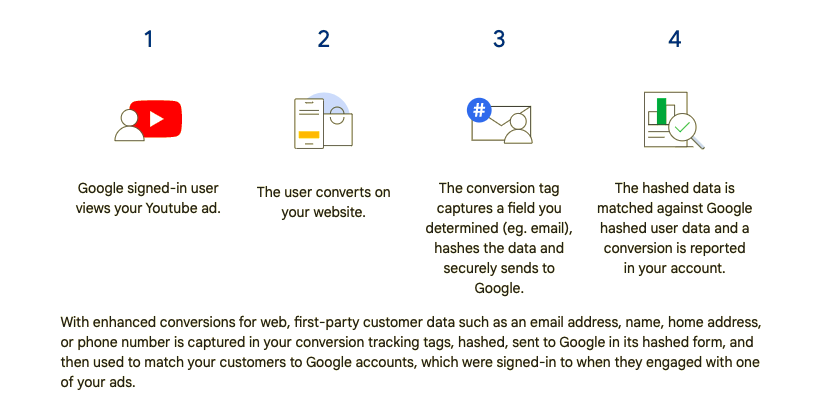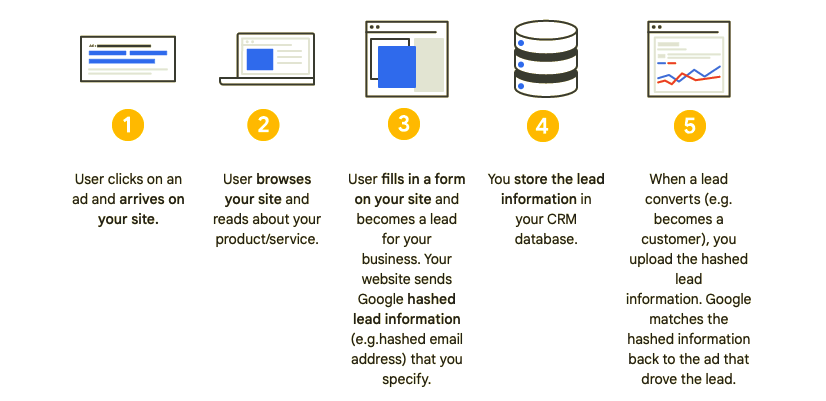Google has made tracking of offline leads conversion more powerful with its newly introduced algorithm. Know how does this algorithm lead to enhance conversion tracking and the advantages of using it.
Being a marketer, it is crucial to know about all the touch points through which prospects or customers interact with the business and also the process through which their leads convert.
It is quite normal to have a gap between the stage where we collect the business leads and the stage where we convert our customers.
Whether the business is B2B or B2C, marketers must have encountered this problem of tracking the campaigns through which prospects start their interaction with the business and finally convert to become the customer.
Though it is not so difficult to measure the effectiveness of campaigns by tracking the customer through every stage when they interact with the business but the process is quite complex and need efforts and time to get the results.
Last year, Google had launched a feature of enhanced conversion for web where it improves the measurement of online sales and events happen within the website. This feature was proved useful for e-commerce businesses and stores that transact online. Now, the new feature was released by Google where it improves the measurement for leads conversion.
This new function of “enhance conversions tracking for leads” will help advertisers tracking conversions that happen outside the online space such as phone calls, closed sales deals and in-store visits.
Here we’ll see how does this technology function and how it can be put to use right away.
What is Enhance Conversion Tracking?
Enhanced conversion tracking is a feature used with existing conversion tags in Google Ads to amplify the accuracy of conversion measurement occurring within and off the website.
You can easily set up this feature by using the Google Tag Manager or configuring the existing global site tag on your website.
Under the process, google site tag collects, and sends the hashed first party customer data to Google in a secured private way.
Data hashing is done using an algorithm called SHA256 (Secure Hash Algorithm 256-bit) that works secretly behind the process.
This first party customer data such as Email Id is compared with the existing database of Google and then used in the same google ad account to report offline conversion.
Depending on how do you use the feature of enhanced conversion for your business, there are two different ways under which hashed data is used to boost measurement.
Types of Enhance Conversion
- Enhanced conversion for web
- Enhanced conversion for leads
Enhance Conversion for Web
Introduction
Enhanced conversion for the web is a feature that helps you track online conversions with more accuracy.
If there is an e-commerce website where people are coming over and making their purchase then this feature uses the hashed data to improve tracking and reporting of all the online conversions to your google ad account.
This feature is used to measure only the events and sales transactions happen within the website.
Steps to Implement Enhance Conversion for Web
There are three different ways through which enhanced conversion for web can be set up:
- Global Site Tag: If you use Global site tag for conversion tracking, then by making slight changes to its configuration, enhanced conversion for web can be applied easily. Changes are discussed here.
- Google Tag Manager: If you use Google Tag Manager for tracking conversions, then again enhanced conversion for web can be set up by doing a few changes to the configuration.
- Google Ads API: Google Ads API is used to implement enhanced conversion for web if you want to provide conversion information using API with more control & flexibility over the data. Steps involved are discussed here
How does Enhance Conversion for Web Work?
There is a visual shared by Google showing the steps involved in Enhanced conversion for web.

Under the feature, customer information is hashed and sent to Google.
On websites, existing tracking tags are used to capture the data. After collecting, this data is converted to hash form and then sent to Google in a safe, private way.
Hashed data means the shared information is confidential, secured, and anonymised.
Then this hashed information is compared to hashed data of users which were signed-in to when they interacted with one of your ad and finally a conversion is displayed in the Google Ad account.
Benefits of Using Enhance Conversion for Web
- Recover conversions that otherwise were not reported or missed out
- Through insightful data, it enhances the bidding optimisation
- It secures the privacy with hashing of first party customer information
Enhance Conversion for Leads
Introduction
Enhanced conversion for leads is a feature that improves the accuracy of your measurement for offline conversions that happen outside the website.
It may include conversions such as in-store purchases, qualified leads and over-the-phone bookings.
Let say a customer comes over and submits his information on your website and later in time that same customer arrives at your store to make purchasing. Then to measure and report this offline conversion accurately in your google ad account, enhanced conversion for lead is used.
Steps to Implement Enhance Conversion for Leads
There are two different ways to set up enhanced conversion for leads:
- Google Tag Manager: If you use Google tag manager for measuring conversions then you can easily set up enhanced conversion for leads by doing slight changes to the configuration. For step-by-step configuration, instructions are available here.
- Global Site Tag: If you’ve global site tag installed on your website then by doing small changes to the configuration, you can easily set up enhanced conversion. For knowing the steps involved in this process, follow here.
How does Enhance Conversion for Leads Work?
Similar to above, there is a visual shared by Google showing the steps involved in Enhanced conversion for leads

Whenever a person submits the information such as Name, Email, Home Address, and Phone Number on your website, you receive a lead in a form of first-party customer information. This information is then hashed and shared to Google.
On the other end, when the same person visits your store and makes purchases (offline conversion). You feed the hashed information of your converted customers back to your Google ad account, from where this information is compared with the hashed information of leads shared earlier.
Finally, these conversions appear in your Google Ad account. This is how enhanced conversion for leads work.
During the process, Google requires at least one of the customer information segments for precise reporting.
- Name
- Email Address
- Phone Number
- Home Address
Benefits of Using Enhance Conversion for Leads
- Easy Set up
- Improved Performance
- Flexible Application
Importance of Using Enhance Conversion in Google AdWords?
We’ve noticed that reporting sales that start on different platforms but end on your own website or off a website is a very difficult task.
And when it comes to reporting conversion for businesses having store front at both offline and online space then it becomes very crucial to keep track of customer to improve marketing & sales efforts.
Enhanced conversion helps you having better data on conversions that are happening with in the website and outside the website right in your Google AdWords dashboard. This data can be further utilised for robust targeting and optimising your promotional campaigns.
In simple words, you can understand that Google has made easier to track the source from where the customer is coming over and interacting with your business and the touchpoint where customer is actually paying for the product and service you offer.
Summary
If you use last click attribution model to know where your customer is converting then this feature will definitely worth to consider.
Using the features of enhance conversion for web and leads, you will be able to optimize campaigns for sales that happen within the website and outside the website.
With that said, this feature of enhanced conversion is quite significant. It includes improved accuracy of conversion measurement for online and offline customers.
Feel free to share with us in the comment sections which feature you like the most or perhaps what you think could have been better. We’ll be happy to take your comments.
